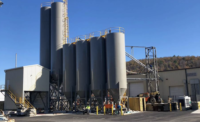New Jersey’s new financial performance bonus for concrete producers that provide low embodied-carbon products for state projects is believed to be the first tax-incentive-based legislation of its kind in the nation. A bill signed into law by Gov. Phil Murphy (D) on Jan. 30 provides an income tax credit of up to 8% of the concrete cost for the development and provision of a product whose carbon footprint is below a soon-to-be set benchmark.
Beginning next year, concrete producers who supply at least 50 yd of concrete for state-funded construction projects will be eligible for a performance-based tax credit if the concrete they deliver for foundations, bridges, sidewalks and other construction also delivers quantifiable embodied-carbon reductions.
State Senator Linda Greenstein (D-Plainsboro), who sponsored the New Jersey Low Embodied Carbon Concrete Leadership Act, calls the law a “crucial step” toward New Jersey’s decarbonization. “Not only will this [law] help to drastically decrease our carbon emissions,” she said in a statement, “but it will also provide economic benefits for the manufacturers of greener technology ….”
The legislation comes at a time of increasing buzz about the climate impacts of concrete production. “If concrete were a country, it would be the third largest [CO2] emitter in the world,” says Allison McLeod, public policy director of the New Jersey League of Conservation Voters, a nonpartisan environmental nonprofit that advocated heavily for the legislation. The production of concrete, whose carbon footprint is largely due to the process of creating cement, accounts for 7% of global carbon emissions.
State and local governments are responsible for 40% of concrete consumption nationally, Greenstein said in an ROI-NJ.com article.
This law uses two strategies to spur business participation in the concrete makeover. One, the direct incentive of 5% of the total project cost for the provision of a low carbon concrete material (up to a $1 million incentive per year for one business), which will be defined by the state Dept. of Environmental Protection. The second component is a 3% credit toward establishing an environmental product declaration (EPD), a means for verifying the carbon footprint of the product.
Each year, the state can issue no more than $10 million in tax credits.
Lionel Lemay, executive vice president of structures and sustainability at the National Ready Mixed Concrete Association, says that incentives are the crucial policy mechanism for manufacturers' cooperation with this approach, especially in a conservative industry.
Even a relatively simple strategy for reducing concrete’s footprint can mean an investment in new infrastructure. Lemay says that a company might need to build a new storage silo just to introduce a new ingredient to the mix—for example—to supplement a portion of heavy emitter portland cement with lower-footprint cementitious materials such as fly ash, slag and silica fume.
The tax credit might not offset the whole cost of a new silo, but Lemay says its impact could still be significant. He says even a $5,000 tax credit “helps offset the costs” and is “better than nothing.”
Carolyn Singer, Greenstein’s communications director, echoes this sentiment. “Concrete is a commodity characterized by high volumes and small profit margins," she says. "This means that a relatively small incentive can have a big influence over the decisions that suppliers make.”
Incentive Seen as Superior to Requirements
Advocates for the legislation see an incentive as superior to requirements that would, for example, force manufacturers to provide concrete below a certain global warming potential (GWP) to bid on projects. Bidding requirements have been used in a few places, including the U.S. General Services Administration standards that received a big splash last March. In December, the US Environmental Protection Agency made an interim determination establishing low-carbon concrete metrics that GSA and US Dept. of Transportation must comply with to receive Inflation Reduction Act funding for large infrastructure projects.
Not everyone agrees with this approach. “There can be hesitation or confusion around mandates,” says McLeod, but an incentive shows that "it makes sense to do this." She adds that "folks become more comfortable with these kinds of practices when they see that it's practical, it can save money and it can also be good for the environment.”
Something that unites all these policy approaches is the establishment of environmental product declarations (EPDs), which are key to measuring carbon footprints and establishing universal benchmarks.
Relying on EPDs
“Practically all of these policies are depending and relying upon environmental product declarations,” says Jordan Palmeri, a senior researcher at the Carbon Leadership Forum. “And these EPDs are third- party verified labels that measure and disclose the environmental impacts of concrete.” In the case of New Jersey, the tax incentive can be used toward the cost of that administrative step.
Whether or not this law will lead to the kind of carbon impact that people are hoping for remains to be seen. A lingering question is just how often a low-carbon bid will actually make it to the top of the pile, since the law does not establish an agency preference or requirement for a low-carbon product. But Greenstein has faith in the policy.
“Fully decarbonizing concrete in a time frame meaningful for climate action will require both the adoption of low-carbon best practices available today and the uptake of new market-ready alternatives as they become available,” she says. “In establishing a tax incentive for outstanding concrete makers, the [law] will help incentivize continuous innovation in decarbonizing concrete, the most widely used material on the planet.”
Editor's note: This article was updated on Feb. 2.





Post a comment to this article
Report Abusive Comment